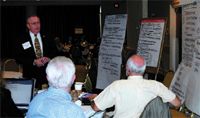Summit attendees deliberate on ways to streamline disaster plans
Arlington, Va. - Five major problems hampered rescue efforts following last year's hurricanes, which displaced an estimated 50,000 animals.
ARLINGTON, VA. — Five major problems hampered rescue efforts following last year's hurricanes, which displaced an estimated 50,000 animals.

Katrina's postmortem: Dr. Lyle Vogel, AVMA's director of Scientific Activities, leads a session to identify ways officials can improve disaster response.
The analysis comes from more than 100 government, humane and veterinary leaders now aiming to create a national system for dealing with animal disaster victims. In May, the newly created consortium gathered for the American Veterinary Medical Association's (AVMA) National Animal Disaster Summit in Arlington, Va. Problems identified include the nation's lack of lead agency on animal disaster relief, broken communications between aid organizations, faulty logistics concerning resource management and a lack of animal evacuation/owner reunification plans.
While the Humane Society of the United States (HSUS) seeks to become the nation's lead disaster agency, AVMA's Executive Board voted last month to budget for a national animal disaster coordinator position within the Scientific Activities Division. Officials soon plan to take applications for the new staff seat.

AVMA's Dr. Janet Donlin adds to the discussion.
AVMA Past President Dr. Bonnie Beaver champions summit's brainstorming work as well as the association's staffing move.
"Following through on the National Animal Disaster Summit it was pointed out that a number of groups wanted AVMA to help serve in a coordinating role to assist animals and people affected by disaster," she says. "The Executive Board stepped up to the challenge and authorized the new position, which provides an exciting opportunity to help all organizations helping in disasters."
The enthusiasm is encouraging, she adds.
"We were extremely happy with the level of participation at the summit," Beaver says. "So many groups want to be involved in coordinated disaster relief."
Apart from identifying key mistakes during Katrina, a national animal disaster Web site was proposed by summit attendees. Resource management, faulty supply routes and a broken chain of command worked to enhance the chaos tied to caring for displaced and abandoned animals. Identified storm shelters, animal-owner evacuation plans and tracking measures are needed to ensure rescue workers are not overwhelmed in the future, experts contend.
A report outlining findings from the two-day summit is slated for an upcoming issue of the Journal of the American Veterinary Medical Association.